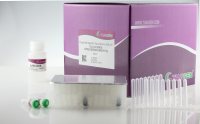Extraction of DNA from Mycoplasmas
互联网
475
The manipulation of genetic material for the purpose of diagnosis or analysis almost always requires the preparation of sample to expose genomic nucleic acid or the extraction and purification of DNA. Molecular techniques, such as restriction enzyme analysis, Southern hybridization, random amplified polymorphic DNA (RAPD) analysis, and nucleic acid sequencing, rely on the purity and integrity of DNA for consistent results. Generally, cells are disrupted mechanically or by detersive agents, proteins inactivated by heat denaturation or enzymatic digestion, and cellular material removed from nucleic acids by phase separation in solvents. Many other methods have been described for the preparation of DNA suitable for amplification and restriction enzyme analysis. Some include new reagents that are mixtures of solvents and result in the reduction of handling time, whereas others are special polymers that sequester or chelate materials other than nucleic acids. The method that combines the action of the detergent sodium dodecyl sulfate (SDS), the proteolytic enzyme proteinase K (PK), and the solvent phenol is widely used for DNA extraction from a variety of eukaryotic and prokaryotic sources. With the exception of pulse-field gel electrophoresis (PFGE), which requires unsheared DNA, this method provides DNA suitable for most techniques, including PCR.






